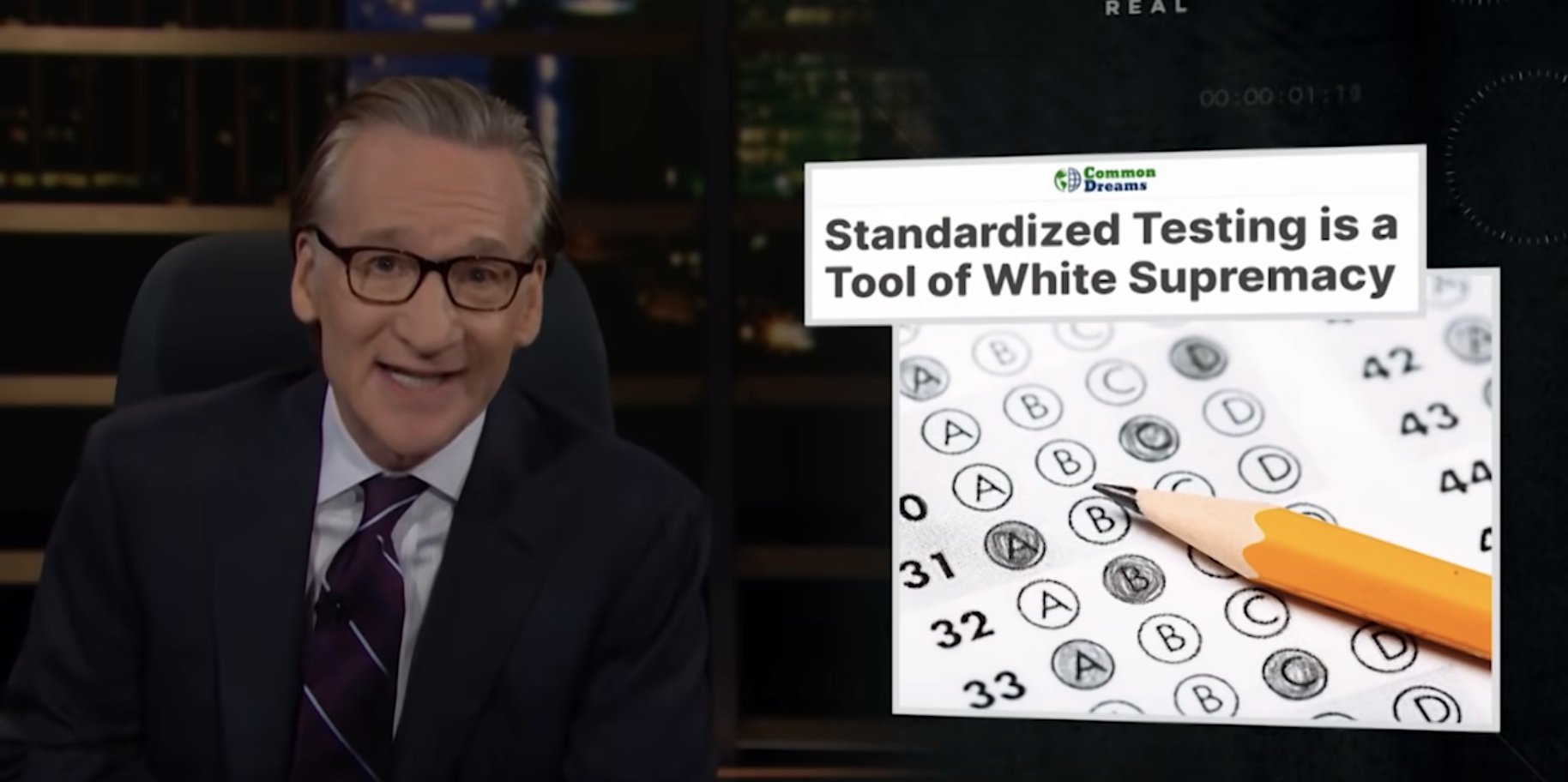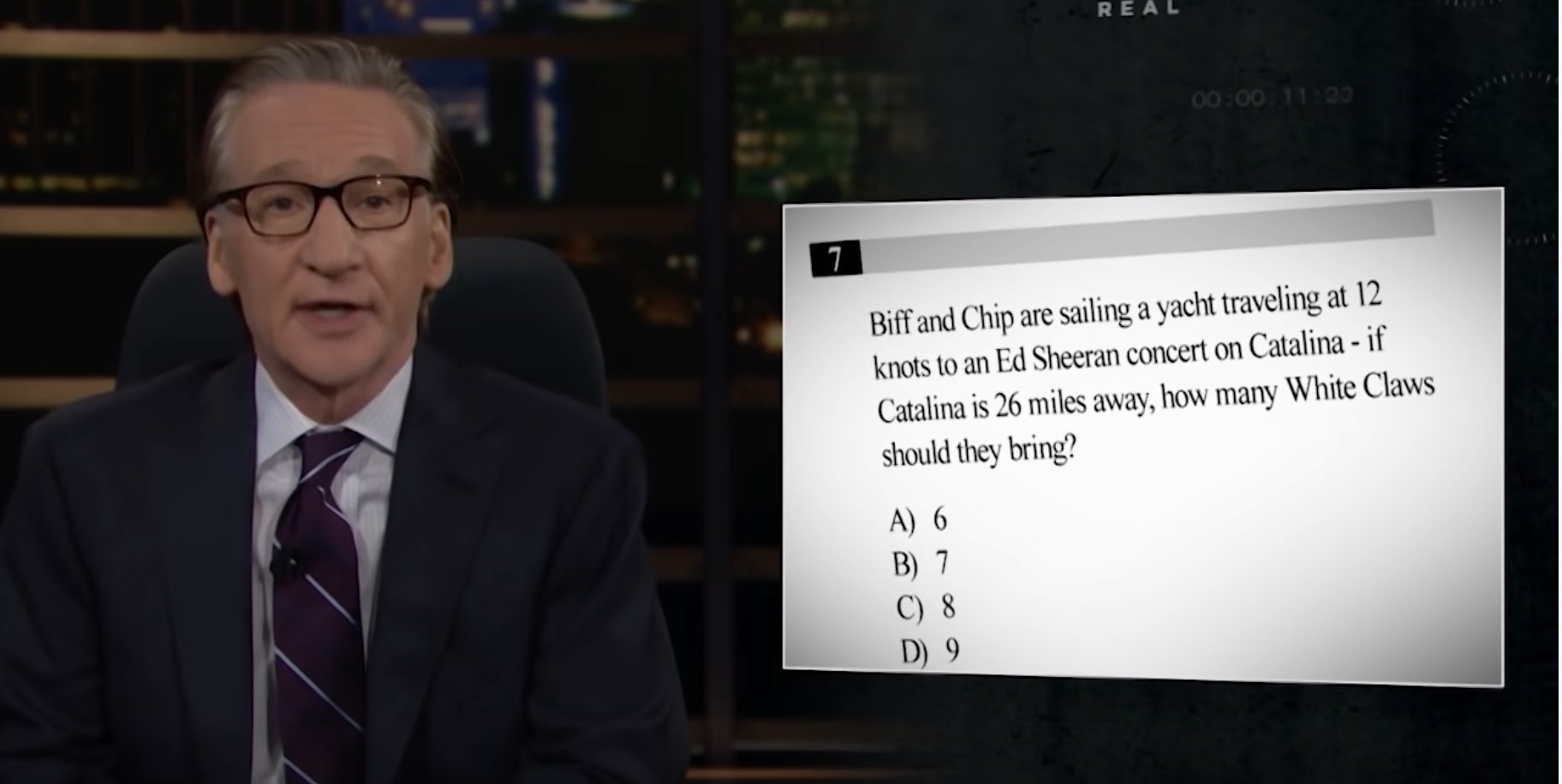I Triggered Bill Maher By Writing About Standardized Testing and White Supremacy by Steven Singer
Bill Maher is mad at me.
And I’ve never even met the man.
I guess you could say we’re from different worlds.
He’s on the West Coast. I’m on the East.
He’s a political comedian. I’m a public school teacher.
He’s a multimillionaire. I can barely make ends meet.
What could I possibly do to provoke the ire of this man so much so that he took aim at me on his HBO TV show?
As near as I can tell, it started when I wrote a blog.
Then people read that blog.
It got popular and was republished throughout the Internet.
And Maher disagrees with what I wrote.
In fact, the very idea annoyed him as a prime example of namby-pamby liberals taking their agenda too far.
What did I write in the article?
Only that standardized testing is a tool of white supremacy.
In fact, that was the title of the article, which seems to be about as far as Bill read because he ignored any arguments, facts or historical citations in the piece.
On his show, “Real Time with Bill Maher” this week, he posted the title of the article and the graphic that appeared with it when it was republished on commondreams.org.
What he didn’t post was my name. I am the author, after all, but I guess that’s not important.
The crucial bit was how triggered Bill was by my assertion.
By connecting such allegedly alien concepts as standardized testing and racism, Maher thinks I devalued the meaning of “white supremacy.”
Maher never actually examined my claim or what I wrote backing it up. Never mind the arguments I made in favor of my point, the sources I cited, the examples of actual bias or the documented history of standardized testing as a creation of the eugenicist movement.
He was content to speak in a smarmy tone and make a pretty lame joke about what a racially biased test question might look like.
In fact, that’s probably why he (and his staff) picked my piece in the first place. They saw it as an opportunity to make a joke and whiffed at it pretty terribly.
Here’s the relevant bit of his monologue:
“In 2010 the New York Times used the term “White Supremacist” on 75 occasions. Last year, over 700 times. Now some of that to be sure is because Trump came along and emboldened the faction of this country that is truly white supremacist. It is of course still a real thing. But it shouldn’t apply to something like – as more than a few have suggested – getting rid of the SAT test. Now if we find the SAT test is slanted in such a way as to stack the deck in favor of Caucasians, if there are questions like Biff and Chip are sailing a yacht traveling at 12 knots to an Ed Sheeran concert on Catalina – if Catalina is 12 miles away, how many White Claws should they bring? Yes, then maybe. But of course the SAT doesn’t have questions like that so it becomes a kind of ludicrous exaggeration that makes lovers of common sense roll their eyes – and then vote for Trump.”
Queue audience laughter and applause.
Funny stuff I guess.
Not the comedy staff’s fake SAT question but Maher’s assurance that “The SAT doesn’t have questions like that.”
Really, Bill?
How about this one?
Runner: Marathon
(a) envoy: embassy
(b) martyr: massacre
(c) oarsman: regatta
(d) horse: stable
It’s a real SAT question famously discussed in the infamous 1994 book, The Bell Curve, by Richard Herrnstein and Charles Murray – a book that tried to use discrepancies in test scores to prove white people are smarter than black people.
The answer is C, and it relies on a test taker’s knowing the meaning of regatta – something more likely to have come up in the daily lives of affluent white students than in the lives of less affluent minority students. If you don’t live by a body of water and/or don’t have much experience with rowing, you’re probably going to fail this question.
It’s the same kind of question Maher’s comedy team came up with – find something white people are more likely to know than black people – but the Real Time writers just pilled it on over-and-over.
It doesn’t take five repetitions of something to make it biased. All it takes is one.
To be fair, my example is from the SAT analogy section, which was removed from the test in 2005. However, that doesn’t mean they got rid of the bias.
It now provides an “adversity score” for poor and minority students to adjust raw SAT scores to account for high schools and neighborhoods “level of disadvantage.”
In other words, they know that poor and minority kids get lower scores so they’re trying to fudge the results to give them a boost.
Which would be entirely unnecessary if the SAT assessed them accurately in the first place.
They are literally trying to make up for how biased their test scores are.
Consider this.
Total SAT scores range from 400 to 1600 – or from 200-800 in both Math and Reading respectively.
According to 2018 data, combined SAT scores for Asian and White students average over 1100, while all other groups average below 1000. Meanwhile, students with family income less than $20,000 score lowest on the test, and those with family income above $200,000 scored highest, according to 2015 data. And the difference is significant – a 433 average Reading score for those with the lowest family incomes compared to an average Reading score of 570 for those with the highest family income. That’s a 137 point difference!
And it holds for racial groups, too. The average Reading score on the SAT was 429 for black students – 99 points behind the average for white students.
However, the College Board is trying to justify this by saying the discrepancy is because poor and minority students are more disadvantaged than white, affluent ones. In other words, it’s not the test that is unfair, but American society in providing better resourced schools with lower class sizes and more resources for white kids than children of color.
And while American society IS unfair to the poor and minorities, several studies indicate that the problem is even deeper than that.
The SAT is biased, too.
Several studies ( Roy Freedle of the Educational Testing Service from 2003, Maria Santelices and Mark Wilson from 2010, etc.) find notable differences between the verbal scores of black and white students whose educational background and skill set suggest that they should get similar scores.
Freedle says this is because SAT questions likely reflect the cultural expressions that are used commonly in the dominant (white) society, so white students have an edge based not on education or study skills or aptitude, but because they are most likely growing up around white people.
This makes sense if you examine how test questions are selected for the SAT. In his book How the SAT Creates Built-in-Headwinds, national admissions-test expert, Jay Rosner, explains the process:
“Compare two 1998 SAT verbal [section] sentence-completion items with similar themes: The item correctly answered by more blacks than whites was discarded by the Educational Testing Service, whereas the item that has a higher disparate impact against blacks became part of the actual SAT. On one of the items, which was of medium difficulty, 62% of whites and 38% of African-Americans answered correctly, resulting in a large impact of 24%…On this second item, 8% more African-Americans than whites answered correctly…”
In other words, the criteria for whether a question is chosen for future tests is if it replicates the outcomes of previous exams – specifically tests where students of color score lower than white children. And this is still the criteria test makers use to determine which questions to use on future editions of nearly every assessment in wide use in the US.
But if all this isn’t enough to convince you that standardized tests really are a tool of white supremacy, consider their sordid history.
They are literally the product of the American eugenics movement.
Modern testing comes out of Army IQ tests developed during World War I.
In 1917, a group of psychologists led by Robert M. Yerkes, president of the American Psychological Association (APA), created the Army Alpha and Beta tests. These were specifically designed to measure the intelligence of recruits and help the military distinguish those of “superior mental ability” from those who were “mentally inferior.”
These assessments were based on explicitly eugenicist foundations – the idea that certain races were distinctly superior to others. In 1923, one of the men who developed these intelligence tests, Carl Brigham, took these ideas further in his seminal work A Study of American Intelligence. In it, he used data gathered from these IQ tests to argue the following:
“The decline of American intelligence will be more rapid than the decline of the intelligence of European national groups, owing to the presence here of the negro. These are the plain, if somewhat ugly, facts that our study shows. The deterioration of American intelligence is not inevitable, however, if public action can be aroused to prevent it.”
Eventually Brigham took his experience with Army IQ tests to create a new assessment for the College Board – the Scholastic Aptitude Test – now known as the Scholastic Assessment Test or SAT. It was first given to high school students in 1926 as a gatekeeper. Just as the Army intelligence tests were designed to distinguish the superior from the inferior, the SAT was designed to predict which students would do well in college and which would not. It was meant to show which students should be given the chance at a higher education and which should be left behind.
And unsurprisingly it has always – and continues to – privilege white students over children of color.
Is it an exaggeration to say that assessments specifically designed to favor affluent white people over impoverished minorities still does the same thing?
Is it ridiculous to describe the century long racial and economic discrepancy in test scores as something that supports white supremacy – especially when these results are shown time and again to be a feature of the tests and not just an artifact that recreates economic inequality?
Is it going too far to call out the racism of the SAT and other standardized tests like it when even the College Board admits its own scores are biased?
Does it devalue the term “White Supremacy” to point out real world white supremacy?
But Maher apparently isn’t interested in these questions.
After a few moments he moved on to another example of the left gone wild.
But I can’t do that because this isn’t just a bit for me.
As I mentioned, I’m a public school teacher.
I deal with the impact of standardized testing every day.
I watch my students degraded, depressed and dehumanized by it year after year.
It’s become cliche for privileged white people like Bill Maher to get cranky when someone points out real world prejudice.
But for those of us in the trenches, it is an everyday reality.
And that’s what triggers me.
Here’s the segment from “Real Time with Bill Maher”: (the relevant bit starts at 4:45)
Like this post? You might want to consider becoming a Patreon subscriber. This helps me continue to keep the blog going and get on with this difficult and challenging work.
Plus you get subscriber only extras!
Just CLICK HERE.
I’ve also written a book, “Gadfly on the Wall: A Public School Teacher Speaks Out on Racism and Reform,” now available from Garn Press. Ten percent of the proceeds go to the Badass Teachers Association. Check it out!


